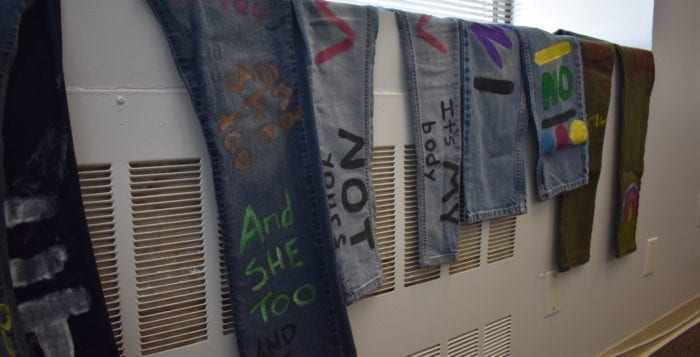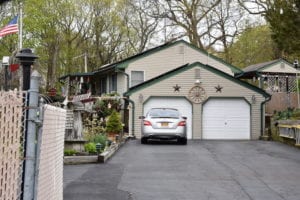Experts talk impact of sex trafficking on North Shore

This post is in regards to a story published on April 25 about Raymond Radio III, who allegedly ran a sex trafficking ring in his parents’ house located in Sound Beach.
The house on Lower Rocky Point Road that allegedly was used by Raymond Rodio III for sex trafficking is well known in the community for its multitudes of colorful lawn ornaments. For residents of the small North Shore hamlet, with a population barely over 7,500, reactions on social media ranged from disbelief to outrage.
But sex trafficking has become a growing front for those linked to the illicit drug trade, and according to those who try and work with those who have been victims of sex trafficking, the trade is well-linked to the middle-class suburban areas of Long Island.

Emily Waters is the director of Human Trafficking Programs at The Safe Center LI, a Bethpage nonprofit that assists the survivors of drug addiction, domestic abuse, child abuse and other issues. She said the issue of sex trafficking has only escalated in recent years, due in part to the opioid crisis that has killed millions across the nation. The center is currently involved with more than 130 human trafficking cases on Long Island, including minors and adults involved in sex and labor, but cases like the one in Sound Beach, she said, are extremely common.
Waters said these human traffickers, often called pimps, use drug addiction as a means of control of these people, mostly women. She said the average age for these young women is 14 or 15 years old, though she has personally been involved, in the United States, with cases of one as young as 9 years old.
“A victim can look like anyone,” Waters said. “Could be anyone from a high socioeconomic background to somebody who’s living in poverty.”
Worse, sex trafficking has become, in many cases, a more profitable business for criminals. Keith Scott, the director of education at the Safe Center, said a pimp could make upwards of $280,000 a year, and that the practice is often harder to prosecute on the polices’ end.
In 2017, the Suffolk County Police Department, at the time headed by Sini, launched a pilot program to go after human traffickers, according to the DA’s office. In 2018, Police Commissioner Geraldine Hart adopted the Human Trafficking Investigations Unit while the DA launched its own team to track human traffickers.
For years, human trafficking has been growing as an issue. Data from the New York National Human Trafficking Hotline show there have been more than 6,400 calls and more than 2,000 cases of sex trafficking for New York since 2007. The vast majority of these are sex trafficking, and the vast majority are with women.
A 2017 report by the U.S Department of Health and Human Services’ Office on Women’s Health said the top sex trafficking venues are commercial-front brothels (with legitimate businesses up front and illegal sex work in the back), online advertising venues such as craigslist and hotel- or motel-based venues.
Those who have worked to get people treatment understand the issue has grown on Long Island, people like Joe Czulada, a graduate of the Riverhead school district and Riverhead resident until recently who moved with his wife to Brooklyn, where she operates a funeral home. Czulada worked as an interventionist, helping to put people into recovery for about five years. He saw the way the opioid epidemic was tied to the illicit sex trafficking industry. What he saw was mostly young women from small hamlets, those who were often addicted to drugs, and whose pimps used that addiction as leverage against them.
“It’s prevalent, it’s become ever more prevalent, the whole industry,” Czulada said. “It’s everywhere, in every small town here on Long Island.”
The work was emotionally draining, especially in seeing people go in and out of recovery, often ending up back on the street or back with the people who abused.
Cases of sex trafficking with prostitutes over the age of consent require proving a form of cohesion. Many cases, like the alleged one of Rodio, come in the form of what Waters called the “chemical tether,” or the trauma bonding between a trafficker and victim. The pimps often come in two forms, ones who expressly use violence to maintain control, and the others who first get the trust of girls, often abusing their need for affection if they come from affectionless backgrounds, and then hooking them on drugs in the process. Scott said opioids are often used, especially in modern cases of sex trafficking, because it makes those victims more docile. Stimulants, like cocaine, are also used often. Those sex traffickers use the threat of withholding drugs as cohesion. In many cases, the pimps will effectively brand women with tattoos, which can range from the pimp’s name to words like “whore,” effectively reducing their chance of being able to get employment if they wished to escape the life.

The biggest misconception when it comes to sex trafficking is that it only happens to those in poverty. Cases like the one alleged in Sound Beach show just how tangible the reality is for middle-class areas. And in the age of the Internet, pimps also find these victims through social media, luring in these young women through the promise of affection and drugs. Waters said recruitment also often occurs at schools. Often sex work is sold through online websites, such as craigslist, but she said it also occurs at more than 20 other websites, and even on mobile dating apps such as Tinder.
Beyond that, it takes a campaign of education, starting with local schools, to keep the community informed. It takes people knowledgeable about the warning signs, and a need for people to call the police if they suspect someone is engaged in sex trafficking.
“People may not know what they’ve seen, but they’ve seen something,” said Scott, who grew up in Smithtown and currently lives in Kings Park. He knows the North Shore and said despite its prototypical sense of suburbia and pockets of wealth, residents need to understand what issues creep into the smallest of residential neighborhoods.
“People often don’t want to realize it’s going on in their own backyard,” he said.






